Passenger cars
ASEAN a market in transition
09 December 2025
20 May 2025
Lubricants deliver excellent protection to plug-in hybrid vehicles in on road extreme cold testing

To appeal to today’s cost and environmentally conscious car buyers, automakers are offering more powertrain options in their model lineups – with plug-in hybrids an increasingly popular choice for consumers. However, the distinctive operating conditions of this configuration bring new challenges for the engine oil. Ruifeng Zhang, Infineum Asia Pacific Team Leader Deep Expertise Engineering, talks about some of the work Infineum has undertaken to better understand these challenges and reveals the results achieved in recent on road lubricant testing under various operating modes in extremely cold conditions.
To reduce the carbon footprint of their lineups, automotive OEMs are developing electrified vehicles, including full battery electric (BEV) and plug-in hybrid and range extended electric vehicles, (PHEV and REEV). Currently, sales of hybrid vehicles are growing, as environmentally aware consumers look for fuel economy gains, without the high price tag, long charge times and range anxiety that can be associated with BEVs. In addition, PHEV offer the driver flexibility, from operating without the internal combustion engine (ICE) – with a pure electric range of over 200 km, to the opposite extreme, when the vehicle can be driven without plug-in charging at all. However, these diverse operating conditions present new challenges for the engine oil including:
Infineum has recently assessed the extent of these potential issues via extensive field trials.
The testing took place in 16 new PHEV in Heihe, a town in Heilongjiang Province northern China, where extremes of temperatures range from over 30°C in summer to -25oC and below in winter.
 The field trial was run in extreme conditions in China
The field trial was run in extreme conditions in China
To enable us to study the difference between PHEV and hybrid (‘HEV’) operation on the same vehicle platform, two of the vehicles were run without battery plug-in charging throughout the test.
Seven fully formulated SAE 0W-20 engine oils, with different performance levels, were evaluated under extremely cold PHEV driving operation, each run in two vehicles. However, one SAE 0W-30 formulation was run in four vehicles, two test vehicles with plug-in charging and two with plug-in disabled (to simulate HEV) so that results could be linked to a previous field test.
The test vehicles were divided into two groups, half with a standard 15,000 km oil drain interval (ODI), the remainder with an extended 30,000 km ODI. The vehicles were driven by a dedicated driver, with all drivers rotating within the group to minimise variations. They followed a defined city driving route where one lap covered 13.3 km and 28 traffic lights, with each vehicle completing one ODI. In this study, four distinct driving cycles (normal, shortened, warm and idle) were used to assess the impact of vehicle operation modes on the various parameters of interest.
The impact of the PHEV operation under extremely low temperatures was investigated through used oil analysis, vehicle operating data log analysis and engine tear down inspection. The results were compared those from previous field trial projects on conventional ICE vehicles, using the same engine family from the same car manufacturer.
Over the course of the field trial, regular and on-demand oil samples were taken and analysed by a third-party laboratory for critical parameters, such as water content, fuel dilution, wear metals, viscosity, oxidation and nitration.
Water content
The frequent yet intermittent use of the ICE while the PHEV is operating, particularly during low-speed urban driving cycles, means the engine oil temperature tends to be lower than that of conventional ICE vehicles. This lower temperature can result in increased water accumulation in the oil. The four distinct driving cycles were used to assess the impact of vehicle operation modes on water accumulation.
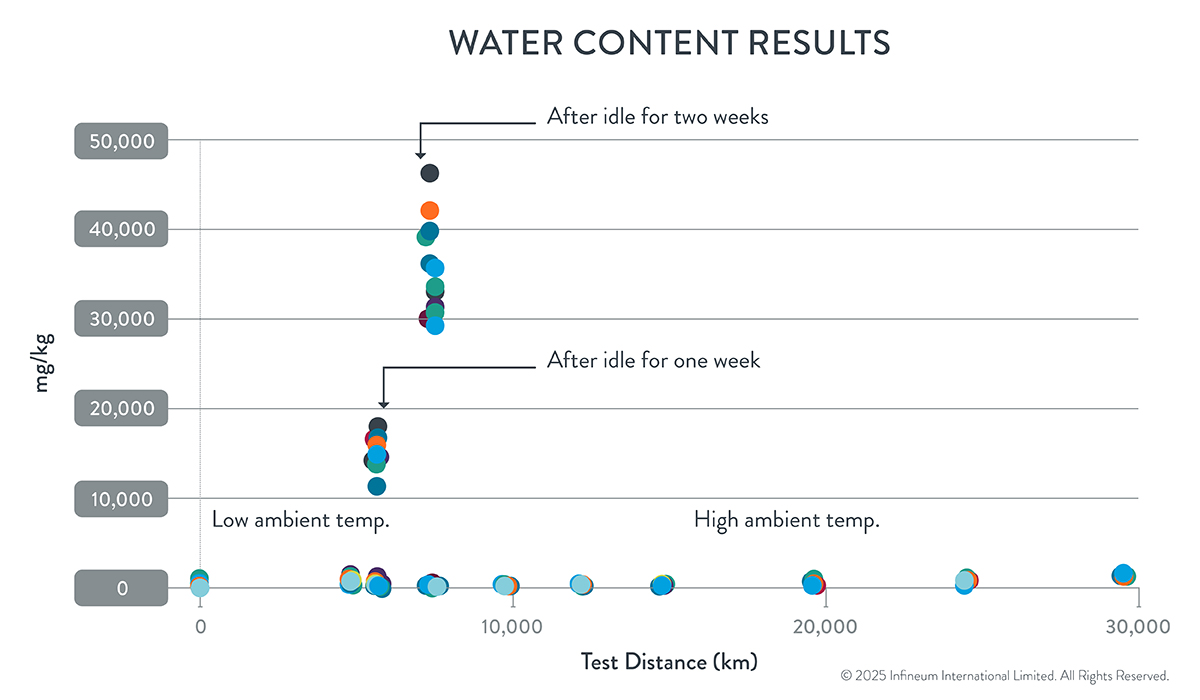
One key finding is that extreme conditions were needed to accumulate water content in the oil. When the oil temperature was under 10°C and the coolant temperature was under 40°C, water content built up continuously in the oil. Our test results indicated that water content remained at a low level (<2,000 ppm) for most of the field trial, except during the idle cycle.
Fuel dilution
Under normal, shortened, and idle cycles, fuel dilution levels as high as 20% m/m were observed when the ambient temperature was low (-30°C to -20°C) and within a relatively short driving distance (<5,000 km). As the driving distance increased and the ambient temperature rose, from winter to mid-summer (up to 30°C), the fuel dilution decreased from its peak level and stabilised at around 3% - 5% m/m. For vehicles operating under the normal cycle, without plug-in charging, the overall ICE activation ratio was higher, and the fuel dilution for these vehicles mainly remained below 6% m/m.
High levels of fuel dilution can significantly reduce the oil viscosity. For example, at a fuel dilution level of 10% m/m, an oil starting the test at SAE 0W-20 becomes SAE 0W-8, which could pose an additional wear risk to vehicles that are not designed to use such thin oils.
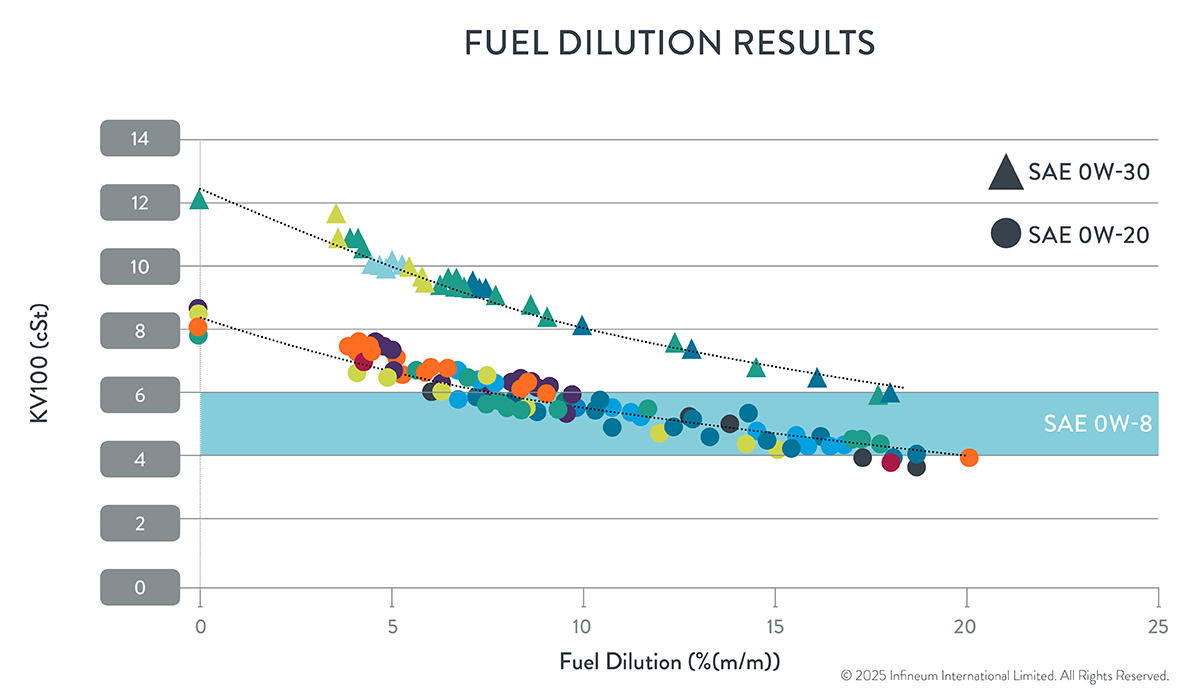
In our experience, using a star polymer (hydrogenated styrene-diene) viscosity modifier (VM) gives better viscometric control performance vs. OCP (ethylene-propylene co-polymer) VM.
Wear Metals
To compare the wear rate in different powertrain configurations, results from a previous field trial using conventional ICE vehicles were incorporated into this study. The highest iron wear rate was observed in the HEV group, and the lowest wear rate in the ICE group, with the PHEV group in the middle. The higher wear rate for the HEV group vs. the PHEV group, under similar oil conditions, could be owing to the greater ICE activation ratio and higher stop-start frequency in HEV compared to PHEV.
With less stop-start frequency, and lower fuel dilution, the wear ratio observed in the ICE vehicles was the lowest of the three architectures, even though the ICE is the sole propulsion unit for the vehicle, and therefore the running cycles here are the highest.
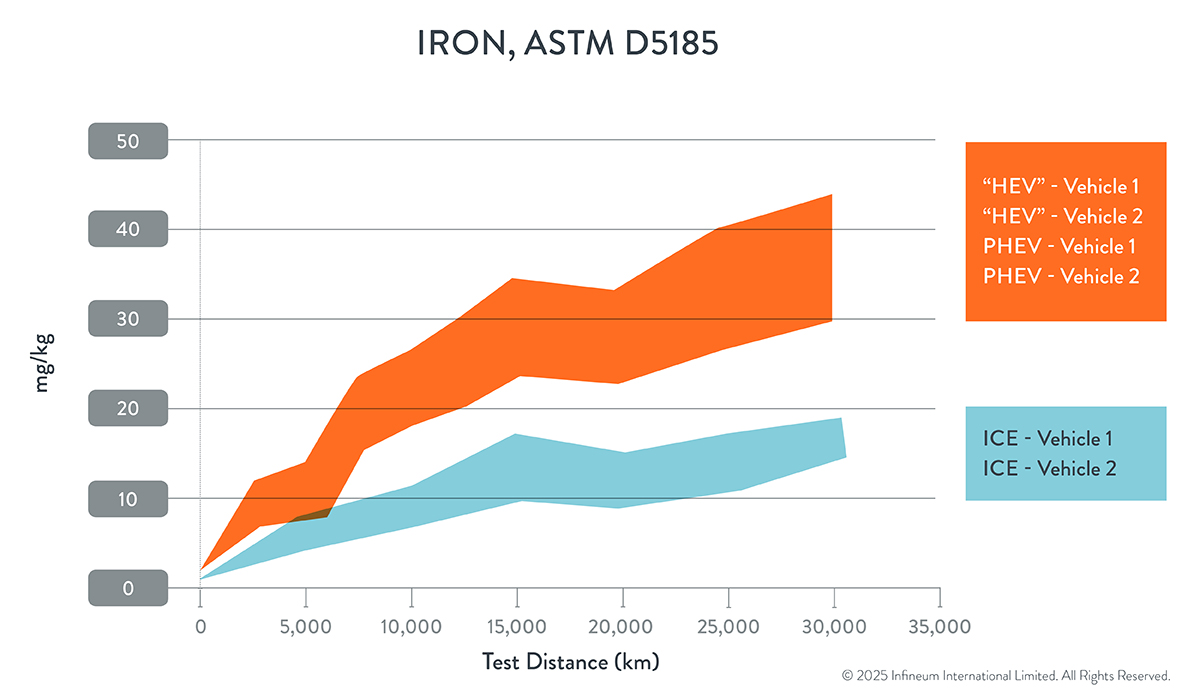
Similar results were observed regarding aluminium wear in that HEV and PHEV wear rates were higher than in ICE vehicles – although the difference between HEV and PHEV was smaller than that observed for iron wear.
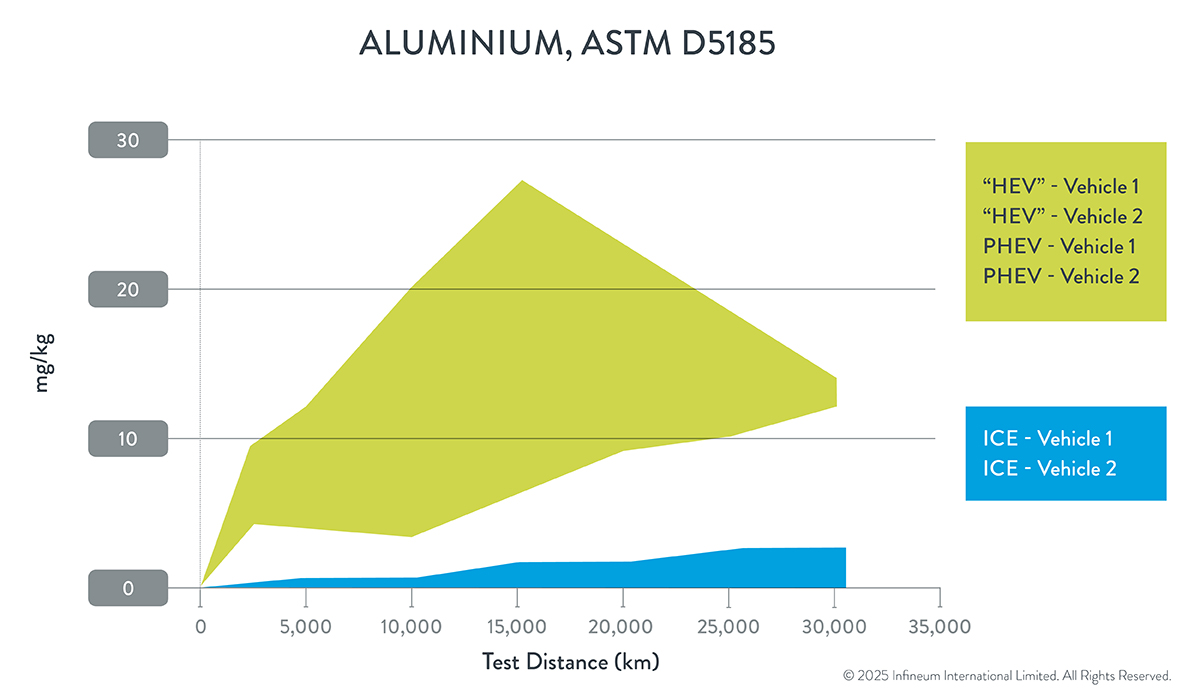
The higher aluminium wear in the hybrids may be caused by the high stop-start frequency, which mean more opportunity for mixed/boundary friction between the plain bearings and journals, which can induce higher aluminium wear on the plain bearings.
At the end of the test, parts were inspected for wear and cleanliness. Here again, to allow the ICE and PHEV wear pattern on the con rod bearings to be compared, the engine inspection results from the previous field trial were employed. Despite the longer driving distance, the wear level on the ICE engine con rod bearings was visibly lower than the PHEV bearings, which is aligned with the used oil analysis results regarding aluminium wear.
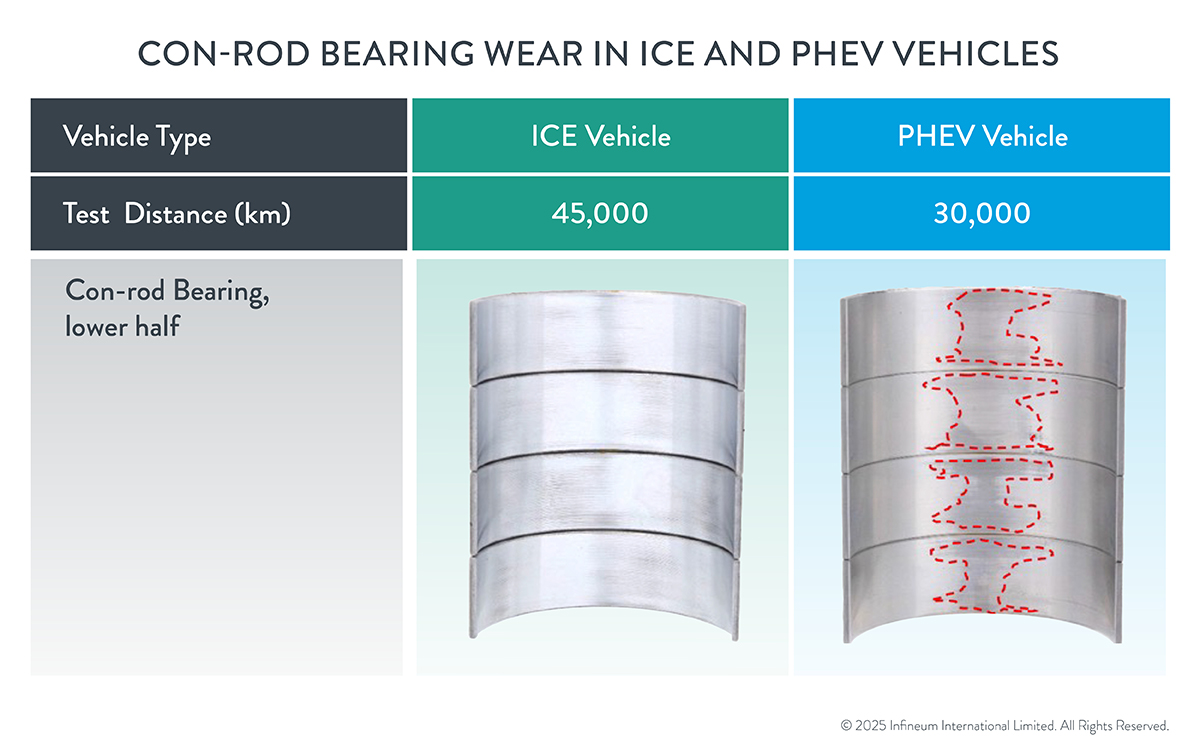
A clean piston and liner assembly can be beneficial to maintaining engine performance and enhancing durability. Comparing the results between HEV and PHEV running on the same oil formulation, no significant difference in piston deposits was observed. However, among the different test oils, a clear performance difference was observed, with, in general, the ACEA performance level oils showing much higher cleanliness performance. This can be attributed to their higher dispersant levels, which perform a key role in maintaining piston cleanliness.
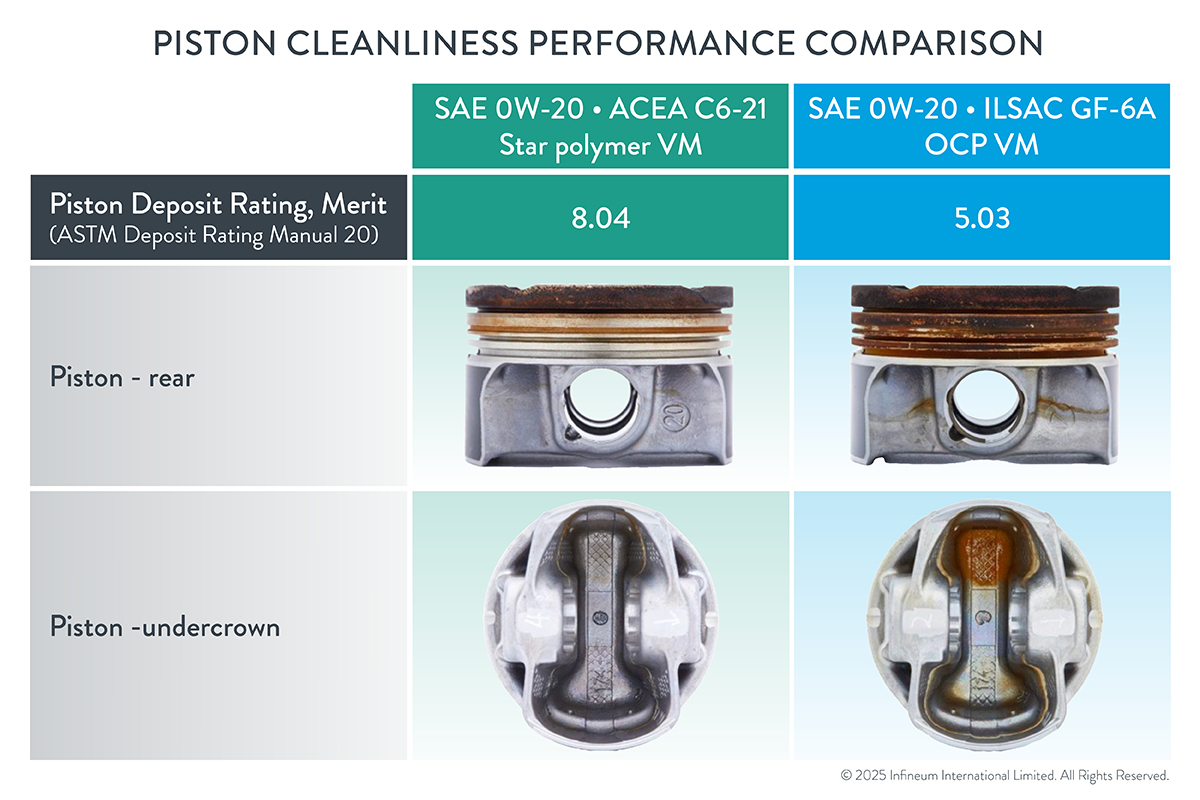
This on-road fleet test has allowed us to explore the impact of PHEV and HEV operation under extreme environmental temperatures and different driving cycles. By incorporating existing results from previous field trials we have also been able to compare these data with ICE performance.
The sophisticated test design has enabled us to study further variables, not only powertrain configuration, driving cycle and temperature but also VM technology and oil formulation.
Overall we have been able to draw a number of conclusions from the results. We have observed that the water content in the oil is governed by a dynamic balance between water entrainment and expulsion, with the former more closely correlated with engine coolant temperature, and the latter with engine oil temperature. In addition, when the ambient temperature is below -20°C, under a low-speed/frequent stop-start driving cycle, fuel dilution can build up to as high as 20% m/m. And, since fuel dilution can significantly thin the oil, more wear between friction pairs such as ring-liner and bearing-journal can occur. Lastly, the increased stop-start severity in HEV vs. PHEV and ICE results in higher rates of iron and aluminium metal wear.
These trials have enabled us to further our understanding of the challenges associated with different powertrains and driving cycles, and to demonstrate the strong performance of some of our products, even under extreme conditions. We are ready with field-proven hybrid fluids to cover a broad spectrum of OEM requirements, now and into the future.
Read another Insight article or watch a video about the hybrid field trial.
Access the full SAE Paper here.
Sign up to receive monthly updates via email
